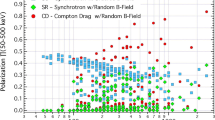Abstract
The Cadmium–Zinc–Telluride Imager on AstroSat has proven to be a very effective All-Sky monitor in the hard X-ray regime, detecting over three hundred GRBs and putting highly competitive upper limits on X-ray emissions from gravitational wave sources and fast radio bursts. We present the algorithms used for searching for such transient sources in CZTI data, and for calculating upper limits in case of non-detections. We introduce CIFT: the CZTI Interface for Fast Transients, a framework used to streamline these processes. We present details of 87 new GRBs detected by this framework that were previously not detected in CZTI.









Similar content being viewed by others
Notes
CZTI pipeline: http://astrosat-ssc.iucaa.in/?q=cztiData.
CIFT is pronounced as sift.
We note that the subsequent arguments become stronger if the actual detected rate is lower as was expected. After completing the search, indeed we found a much lower GRB rate.
References
Abbott R., Abbott T. D., Abraham S. et al. 2020, GWTC-2: Compact Binary Coalescences Observed by LIGO and Virgo During the First Half of the Third Observing Run, arXiv:2010.14527
Abraham S., Mukund N., Vibhute A. et al. 2019, ArXiv e-prints, 1906.09670, arXiv:1906.09670
Anumarlapudi A., Bhalerao V., Tendulkar S. P., Balasubramanian A. 2020, Astrophys. J., 888, 40
Bhalerao V., Bhattacharya D., Rao A. R., Vadawale S. 2015, GRB Coordinates Network, 18422, 1
Bhalerao V., Kumar V., Bhattacharya D., Rao A. R., Vadawale S. 2016, GRB Coordinates Network, 19519, 1
Bhalerao V., Kasliwal M., Bhattacharya D. et al. 2017a, Astrophys. J., 845, arXiv:1706.00024
Bhalerao V., Bhattacharya D., Vibhute A. et al. 2017b, J. Astrophys. Astr., 38, 31
Chattopadhyay T., Gupta S., Sharma V. et al. 2021, J. Astrophys. Astr., 42, https://doi.org/10.1007/s12036-021-09718-2
Gruber D., Goldstein A., Weller von Ahlefeld V. et al. 2014, 211, 12
Gupta S., Sharma V., Bhattacharya D. et al. 2020, GRB Coordinates Network, 28451, 1
Hunter J. D. 2007, Computing in Science & Engineering, 9, 90
Lex A., Gehlenborg N., Strobelt H., Vuillemot R., Pfister H. 2014, IEEE Trans. on Visualization and Computer Graphics, 20, 1983
Li C. K., Lin L., Xiong S. L. et al. 2020, arXiv e-prints, arXiv:2005.11071
Lien A., Sakamoto T., Barthelmy, S. D. et al. 2016, Astrophys. J., 829, 7
Marathe A., Sharma Y., Bhalerao V. et al. 2019, GRB Coordinates Network, 24972, 1
Mate S., Bhalerao V., Bhattacharya D. et al. 2017, GRB Coordinates Network, 20796, 1
Mate S., Chattopadhyay T., Bhalerao V. et al. 2021, submitted to J. Astrophys. Astr., 42, https://doi.org/10.1007/s12036-021-09763-X
Mereghetti S., Savchenko V., Ferrigno C. et al. 2020, Astrophys. J. Lett., 898, L29
Narayana Bhat P., Meegan C. A., von Kienlin A. et al. 2016, 223, 28
Rao A. R., Chand V., Hingar M. K. et al. 2016, Astrophys. J., 833, 86
Ratheesh A., Rao A., Mithun N. et al. 2021, J. Astrophys. Astr., 42, https://doi.org/10.1007/s12036-021-09716-4
Robitaille T. P., Tollerud E. J., Greenfield P. et al. 2013, A&A, 558, A33
Scargle J. D., Norris J. P., Jackson B., Chiang J. 2012, Astrophys. J., 764, 167
Sharma Y., Bhalerao V., Khanam T. et al. 2018, GRB Coordinates Network, 23511, 1
Shenoy V., Aarthy E., Bhalerao V. et al. 2020, GRB Coordinates Network, 27315, 1
Shenoy V., Sharma Y., Bhalerao V. et al. 2019a, GRB Coordinates Network, 26378, 1
Shenoy V., Sharma Y., Bhalerao V. et al. 2019b, GRB Coordinates Network, 26376, 1
Shenoy V., Sharma Y., Bhalerao V. et al. 2019c, GRB Coordinates Network, 26268, 1
Shenoy V., Bhalerao, V., Gupta, S. et al. 2020, GRB Coordinates Network, 28354, 1
Singh K. P., Tandon S. N., Agrawal P. C. et al. 2014, in Takahashi T., den Herder J.-W. A., Bautz M., eds, Space Telescopes and Instrumentation 2014: Ultraviolet to Gamma Ray, vol. 9144, 91441S
van der Walt S., Colbert S. C., Varoquaux G. 2011, Computing in Science & Engineering, 13, 22
von Kienlin A., Meegan C. A., Paciesas W. S. et al. 2014, 211, 13
von Kienlin A., Meegan C. A., Paciesas W. S. et al. 2020, Astrophys. J., 893, 46
Acknowledgements
CZT-Imager is built by a consortium of Institutes across India. The Tata Institute of Fundamental Research, Mumbai, led the effort with instrument design and development. Vikram Sarabhai Space Centre, Thiruvananthapuram provided the electronic design, assembly and testing. ISRO Satellite Centre (ISAC), Bengaluru provided the mechanical design, quality consultation and project management. The Inter University Centre for Astronomy and Astrophysics (IUCAA), Pune did the Coded Mask design, instrument calibration, and Payload Operation Centre. Space Application Centre (SAC) at Ahmedabad provided the analysis software. Physical Research Laboratory (PRL) Ahmedabad, provided the polarisation detection algorithm and ground calibration. A vast number of industries participated in the fabrication and the University sector pitched in by participating in the test and evaluation of the payload. The Indian Space Research Organisation funded, managed and facilitated the project. This work utilised various software including Python, AstroPy (Robitaille et al. 2013), NumPy (van der Walt et al. 2011), Matplotlib (Hunter 2007), https://github.com/jnothman/upsetplot/UpSetPlot (Lex et al. 1983), and ngrok.
Author information
Authors and Affiliations
Corresponding author
Additional information
This article is part of the Special Issuse on “AstroSat: Five Years in Orbit”.
Rights and permissions
About this article
Cite this article
Sharma, Y., Marathe, A., Bhalerao, V. et al. The search for fast transients with CZTI. J Astrophys Astron 42, 73 (2021). https://doi.org/10.1007/s12036-021-09714-6
Received:
Accepted:
Published:
DOI: https://doi.org/10.1007/s12036-021-09714-6




